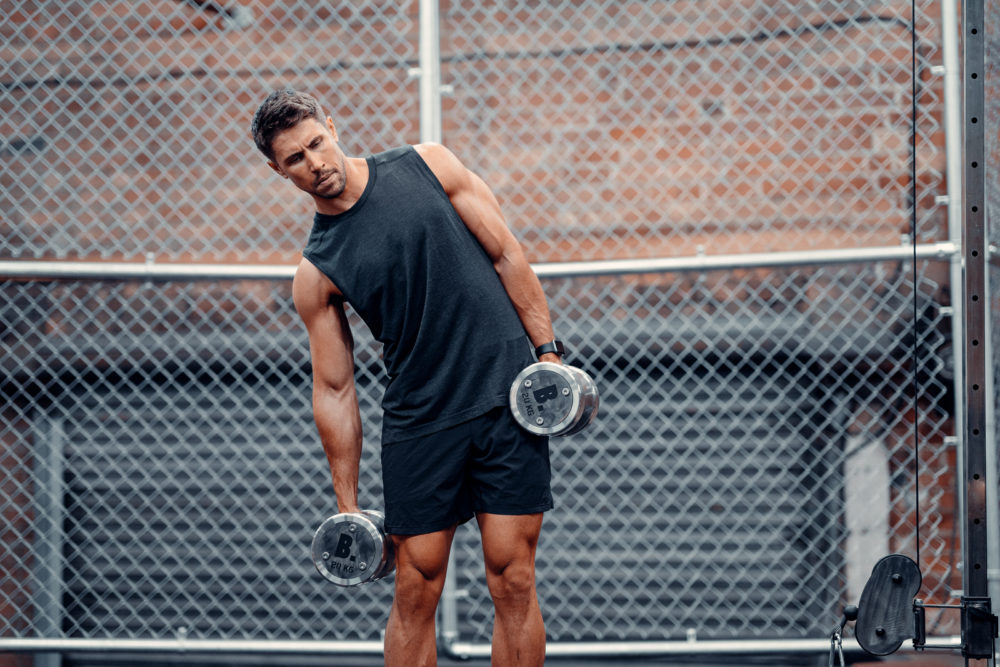Dumbbell side bends are a common obliques exercise that require you to laterally flex your spine. The belief might be you’re chiseling your obliques, but when performed incorrectly you might be putting yourself at far greater risk than reward. Scroll down to the bottom to see what you should do instead, but first here’s what not to do.
The dumbest obliques exercise
Dumbbell side bends are most commonly done with one dumbbell but you’ll often see them being done with two dumbbells as well. While the spine is designed to to laterally flex, anytime you do so you want it to be doing some good. You also want them to be working to strengthen the structures that support your spine.
Bending side-to-side with two dumbbells of equal weight will only work to fight against each other. While one dumbbell pulls you in to lateral flexion on one side so does one of equal weight on the other. You’ll have higher core activation doing this with versus without dumbbells, but doing it with just one dumbbell is better than two.
What’s wrong with single dumbbell side bends?
While there’s nothing wrong doing side bends with a dumbbell in one hand, they’re often performed incorrectly and with far greater risk than reward. There are a few problems here, but I’d like to keep this article short and straight to the solution. The main one, however, being that with improper technique or abdominal tension, the dumbbell pulls you in to an excessive range of motion. This is largely because the direction the dumbbell is pulling you in.
Essentially the dumbbell pulls you outside of the active range of motion where your obliques should otherwise be maintaining tension. Not only does this tension set of the cascade of events that ultimately leads to chiseled abs, but increasing tension to stabilize your spine in this range of motion too.
With a loss of efficiency of your obliques (both external and internal obliques) as well as other core muscles, this puts your spine at more risk. Not only this but your obliques aren’t getting much of a workout here either. Sure, your obliques will be sore tomorrow from being overstretched, but in the long run the higher-risk-low-reward nature won’t be doing you much good.
The cable advantage
Using cables allow you to change the point where the load is maximized. Cable side bends are more controllable, you can achieve more with less weight, and they allow you to stay within an active range of motion for your obliques. Not only that but as you’re being pulled towards the cable, your hip stabilizers have to work extra hard to resist collapsing in to adduction.
Cable side bends are a more “complete” and integrated core exercise. Here’s what they should look like.
Cable height
In the video I’m showing a low cable setup. Depending on the height of the cable you can load different portions of the movement more or less. For example with a low cable the point of maximal load is greatest as I’m near the full sideways bend. This is evident by the angle of the cable relative to my torso (closer to 90 degrees).
If the cable were high — also a good option — load from the cables would be greatest as I’m stood fully upright, but less as I begin to bend sideways. Point being you can vary the height of the cables to change the emphasis and feel of the exercise. Feel free to experiment.
Squished between glass
Imagine you’re stuck between two panels of glass. Your nose would squish if you moved too far forward, or your butt would press against the glass behind if you bent your hips in the wrong direction. Your focus here should be on isolating lateral flexion of your spine. This often requires a much smaller movement than what you’re used to, but performing them like this is way more effective.
Any physical therapist will also tell you that combining spine lateral flexion with some flexion and rotation at the same time is a disaster waiting to happen. Minimize risk and maximize the benefits by sticking to isolating the lateral flexion component of this obliques exercise, only.
Spread the floor
As we’ve already mentioned the beauty of the cable is that you’re being pulled towards it. This requires your hip abductors to work hard to resist your hips from collapsing. This means your glutes get a great isometric workout here too.
Imagine “spreading the floor” with your feet and pinching your glutes to lock you in position. The rest is all about isolating lateral flexion as we’ve spoken about already. Placing your opposite arm on your head helps you feel the loaded stretch on that side too.
Summary
Using a cable makes for a smarter obliques exercise compared to dumbbells. Use cable side bends to train your obliques as lateral flexors while integrating your hip abductors as well. Generally speaking sets of 12-15 focused reps work best for these, depending on your goals.


